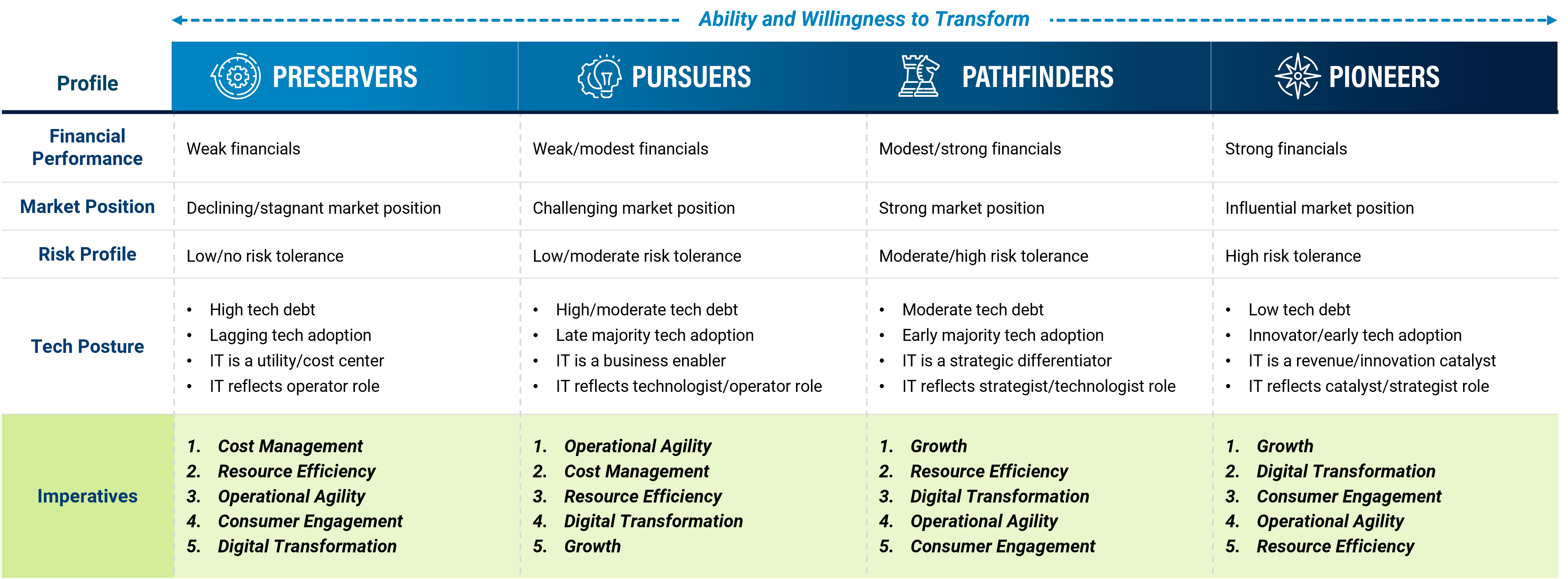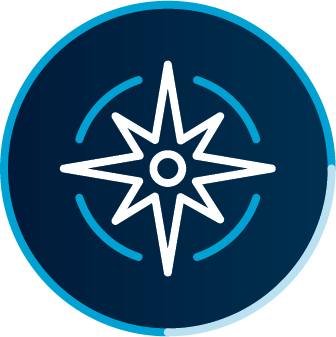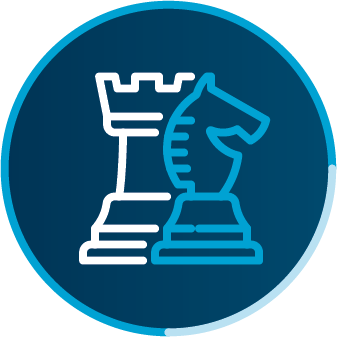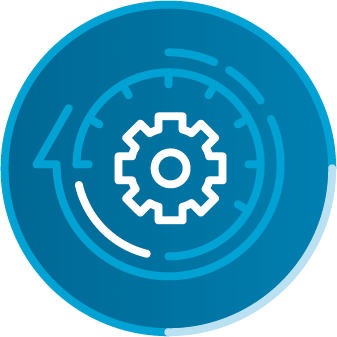Health Systems and The Four Archetypes
Published on April 1, 2024
Michael Kleinmann | Managing Director
Key Takeaway
The 2024 health care landscape’s evolution demands health systems navigate technological, patient-centric, and efficiency transformations reflective of their archetype (Pioneers, Pathfinders, Pursuers, Preservers). The strategic focus of each health system should be on enhancing patient care and operational effectiveness through tailored technological adoptions.
- Embracing artificial intelligence (AI), digital innovations, and robust cybersecurity is vital for organizations to align with prevailing health care demands and safeguard patient information. The choice of technology investments should consider the health system’s archetype to ensure relevance and impact.
- Recognizing their archetype enables health systems to implement practical strategies that leverage their existing strengths, whether it’s through AI for improved health outcomes, enhancing patient engagement digitally, prioritizing data security, or reducing costs.
- Adapting to patient-centric approaches, investing in modern technology, and fostering innovation are key for health systems to remain resilient and competitive. This strategic alignment with their current reality positions them for success in a rapidly evolving health care environment.

The health care industry in 2024 is a landscape of transformation, marked by the fusion of clinical care with cutting-edge technology, an overhaul of traditional business models, and a concerted shift towards patient-centric service delivery. The prevailing financial, operational, and competitive pressures, coupled with the rapid advancements in digital health, artificial intelligence (AI), and a heightened emphasis on cybersecurity, are defining the imperatives for health systems and their leaders.
Within this transformative phase, we can discern four distinct health system archetypes — Pioneers, Pathfinders, Pursuers, and Preservers — each with its own set of characteristics and priorities, navigating the health care realities of the day with varying degrees of agility and innovation. In this post we will take a look at each of the archetypes and reflect on strategies executives, in particular chief information officers (CIOs), can take depending on their organizational archetype.
Pioneers, Pathfinders, Pursuers, and Preservers

Pioneers are at the industry’s helm, guiding the charge towards uncharted territories with strong financials and a bold market stance. Their high-risk tolerance and forward-thinking tech posture make them ideal candidates to capitalize on AI, emerging tech, and digital solution investments that enhance patient outcomes and drive operational efficiency. In the face of tightening financial belts, Pioneers must leverage their resources to modernize core platforms, embrace cybersecurity measures, and diversify their services to maintain sustainability and growth.
Actions for CIOs
For Pioneers, the action plan involves leveraging their financial strength to invest in breakthrough technologies, such as AI and machine learning, to foster a culture of innovation. They should also look to form strategic alliances with tech companies, investing in start-ups, and building an ecosystem that promotes continuous innovation.

Pathfinders, akin to strategic chess players, possess a more balanced approach to risk and innovation. They have the potential to become industry leaders by continuously improving their operational models and investing in technology that aligns with their growth-oriented vision. The challenge for Pathfinders lies in striking a balance between workforce management and patient demand, particularly as the shift towards value-based care and mental health services intensifies.
Actions for CIOs
Pathfinder CIOs should prioritize digital transformation initiatives that enhance patient engagement and improve care delivery. They need to adopt a growth mindset and focus on developing strategies that leverage their existing strengths to explore new opportunities for expansion and technological advancement.

Pursuers, with their modest financial and market positions, often find themselves in reactive stances, grappling with the need to adopt digital transformations to remain competitive. In the current climate, Pursuers should prioritize operational efficiencies and embrace cost-effective care pathways to navigate the financial squeeze. They must be adept at integrating technology solutions that offer both improved patient engagement and operational returns, all while managing the critical issue of workforce burnout.
Actions for CIOs
CIOs in Pursuer health systems must formulate a plan that involves a careful balance between innovation and cost-efficiency. Their strategy should include adopting scalable technologies that can grow with the organization, optimizing current tech investments, and gradually moving toward more advanced digital solutions as financial health improves.

Preservers, amid financial constraints and technological limitations, need strategic action for sustainability – optimizing operations and finding efficiency in their existing processes. Preservers should modernize core systems through cost-effective, cloud-based solutions and seek strategic partnerships that provide access to shared resources and capabilities. Preservers should follow a cautious yet forward-moving strategy towards stabilization and incremental improvement within tight constraints, inclusive of fully embracing data analytics, leveraging AI in a measured manner, enhancing the patient experience, and deploying telehealth services.
Actions for CIOs
For Preservers, the action plan focuses on optimizing what is already in place — streamlining operations, enhancing efficiency, and making the most of existing technology to improve patient outcomes, while keeping an eye on costs. Preservers should carefully monitor industry moves for proven use-cases involving AI to derisk their eventual investments in these opportunities.
For hospital executives, the path forward involves a strategic synthesis of these realities with the imperatives of their archetype. Across the board, AI and cybersecurity will heavily influence strategies adopted by the c-suite:
- Pioneers should continue to push the envelope in digital health, develop AI solutions to streamline operations, and create patient-centric care models, all while ensuring robust data security.
- Pathfinders must judiciously expand their telehealth offerings and remote monitoring services, harness the power of data analytics for patient outcome tracking, and engage in partnerships that amplify their market reach and capabilities.
- Pursuers need to integrate cost-effective digital tools, prioritize operational agility, and address workforce challenges through AI and analytics to optimize staffing and reduce administrative burdens.
- Preservers should focus on leveraging technology to optimize existing processes, engage in careful dealmaking to extend their capabilities, and address the demands of consumerism with strategic digital patient engagement tools.
Each archetype’s action plan hinges on a unified theme: the thoughtful integration of AI and digital solutions, a focus on cybersecurity, a need for data quality, and a responsive adjustment to the evolving demands of patient care. The aim is not simply to survive the waves of change but to harness their power, positioning themselves to thrive in a health care ecosystem that is as challenging as it is promising.
As hospital executives chart their course through 2024 and beyond, they must do so with an eye on the ever-evolving health care realities, leveraging technology not just as a tool for operational efficiency, but as a cornerstone for reimagining patient care, workforce enablement, and overall organizational resilience.
Frequently Asked Questions
In what ways can health systems ensure that their actions align with their archetype’s long-term goals and vision, especially amidst evolving market dynamics and technological advancements?
Health systems must continually reassess their strategies and adapt to changing market dynamics and technological advancements to ensure alignment with their long-term goals and vision — annual strategy-setting efforts are no longer sufficient. This may involve regularly reviewing performance metrics, engaging support from third parties for an outside-in perspective, and staying informed about industry trends and emerging technologies to make informed strategic decisions.
What strategies can health systems in the Preserver archetype employ to gradually integrate AI and data analytics into their existing processes without disrupting their established equilibrium?
Preservers can adopt a phased approach to integrating AI and data analytics, starting with pilot projects in areas where they can demonstrate clear value without significant disruption. They should prioritize solutions that complement their existing workflows and address specific pain points, such as optimizing patient scheduling or improving inventory management. By focusing on incremental improvements and gradually building organizational capacity, Preservers can leverage AI and data analytics to enhance patient outcomes and operational efficiency, while minimizing disruption to their established equilibrium.
How can health systems in the Pursuers archetype effectively balance the adoption of digital transformations to remain competitive, while managing the financial constraints typically associated with their market position?
Pursuers can balance digital transformation and financial constraints by prioritizing cost-effective digital tools that offer tangible returns on investment. They should focus on scalable technologies that align with their budgetary constraints and demonstrate clear benefits in terms of improved patient engagement and operational efficiency. Additionally, pursuing strategic partnerships with technology vendors or adopting subscription-based models for digital solutions can help spread costs over time and minimize upfront investment.
How can Pathfinder health systems effectively balance their focus on innovation with the need to maintain operational stability and ensure continuity of care for patients?
Pathfinders need to strike a balance between innovation and operational stability to ensure continuity of care for patients. They can achieve this by adopting a phased approach to innovation, prioritizing initiatives that align with their strategic vision and core competencies. Additionally, engaging frontline staff and patients in the innovation process can help identify opportunities for improvement, while minimizing disruptions to existing workflows. By fostering a culture of continuous improvement and adaptability, Pathfinders can effectively navigate the evolving health care landscape, while maintaining high standards of patient care.
How can Pioneer health systems effectively manage the potential risks associated with their bold adoption of breakthrough technologies, such as AI and machine learning, while ensuring patient safety and data security?
Pioneers must prioritize patient safety and data security as they adopt breakthrough technologies like AI and machine learning. They can mitigate risks by implementing robust cybersecurity measures, conducting thorough testing and validation of AI algorithms, and adhering to regulatory standards such as HIPAA. Additionally, fostering a culture of transparency and accountability within the organization can help identify and address any potential risks or ethical concerns associated with the use of advanced technologies.

